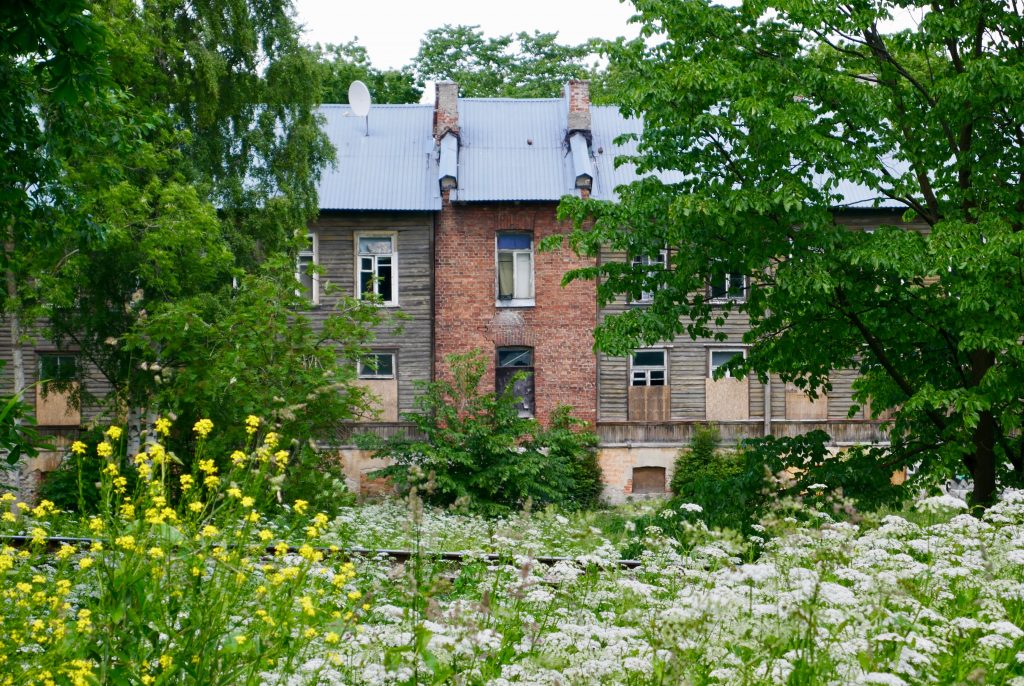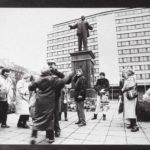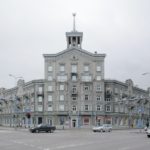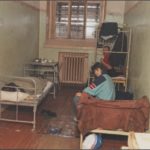Derelict; dangerous; destroyed; destitute. Kopli Lines has been one of the most problematic areas of Tallinn for decades. Vacant shells of former homes sporadically occupied by squatters and always in the news for the wrong reasons; many locals fear this area and no tourists ever visit.
So, what’s the story?
How does a community surrounded by natural beauty and tranquility on the Baltic coast become, for want of a better word, a slum?
Where are “The Lines”?
A good place to start. The Kopli Lines are here…
Notice the street names: ‘Line 1’, ‘Line 2′, Line 3’, ‘Line 4’ and ‘Line 5’. Now you get the name; Kopli Lines. Imaginative, huh?
What’s the story?
Birth of “The Lines”
Firstly, what are the Kopli Lines? What are we actually talking about here?
A good question: this area is a tiny network of cobbled streets and simple barrack-style wooden structures built to house the workers of the Russo-Baltic Shipyard. Essentially, a miniature village for employees and their families.
The architects behind the complex envisioned an idyllic working class community, complete with all the essential institutions that a growing family would need. “The Lines” formed the central hub of the new working class community.
Almost overnight, the Kopli Peninsula turned from an uninhabited forest into a small town complete with a schoolhouse, canteen, sewage system, medical facilities, tramlines and even a sauna (all the essentials).

1920s-1930s
After World War One the city no longer required such a sizeable shipbuilding enterprise and the Russo-Baltic factory went bankrupt, passing into government hands. Investment continued however and by the 1930s Kopli Lines was one of the most valued and sought-after working class communities in the city.
The location was peaceful with direct access to the sea, housing was fully functional and there was a schoolhouse, medical centre and grocery store.
In theory, residents would never need to leave the area in order to meet their daily needs.

Post-World War Two decline
After the Second World War, TWO major changes occurred;
1) Social changes
- Series of fire and structural problems left “the Lines” incomplete and in need of attention
- Funding had gone elsewhere, towards more profitable house-building projects
- Influx of migrants from Soviet territories changed the identity of “the Lines”. New residents struggled to adapt to life in this new district and social problems began to spiral
- Neglect became the default policy; an approach that has not changed
2) Economic changes
- The Soviet government did not allow locals to privatise their houses. All but the most basic maintenance funding was scrapped.
- Social Cleansing: Wooden houses in Kopli used as part of a relocation program to force poorer families out of the evermore desirable Kalamaja district
- The introduction of Tallinn’s poorer residents saw the reputation of Kopli Lines fall even lower

What’s the situation in Kopli Lines today?
“The Kopli Lines are in the mental picture of other townspeople a gathering place for bums with squalid houses on the verge of collapse where a “normal person” cannot live.”
Katrin Paadam – “The Kopli Lines – Is the Path of Decline Our Own or Foreign?”
This is the overwhelming reputation.
The remaining ‘residents’ of Kopli Lines are termed the ‘new poor’. Unemployed, homeless, drug addicts and alcoholics squat in the abandoned wooden houses as the area becomes increasingly uninhabitable.
Regular fires claim the lives of several squatters each year.
While long term residents do exist they are located the other side of the tramlines in the adjacent ‘Professor’s Village’, an area of wooden houses that have survived the decline of Kopli.
NOTE: There is definitely an aura of fear hanging over Kopli Lines.
A study in the year 2000 uncovered that Kopli Lines was one of the most dreaded areas of the city. The overwhelming majority of those asked had never stepped foot there.
Although the reputation is justified, one can’t help but wonder if this climate of dread has played a part in the long term decline of this community. Who is to blame for the fait of “the Lines”: the residents, or subsequent governments? Could the Lines have been saved decades ago if this cloud of fear had never been allowed to form?
Food for thought.

Beauty in Decay
For the adventurer, photographer, urban explorer or historian, the Kopli Lines are undoubtedly a beautiful preserved window into the past.
The layout of the streets is still discernible and the derelict wooden houses are in tact enough to allow the imagination to travel back to a time when this was a functioning working class community.
Painted wooden panels, old wooden doors and even curtains survive, proving that there is a tangible story behind this dereliction.
The Lines were not always like this and on a quiet afternoon, standing in and amongst this ghost town, this is easy to appreciate.

Should I go?
This is an urban explorers paradise and definitely a mission for the more adventurous traveller.
Be very careful if you enter the houses. They are not safe both structurally and socially. Personally, I have never ventured inside. The area is so substantial that there is enough to explore without venturing inside. Many of these mysterious structures cross the line between ‘cool abandoned building’ and ‘derelict ruin’.
I have visited Kopli Lines many times and it still remains an engrossing and exciting area to explore.
If you do decide to visit – now is the time. Kopli Lines will be at the heart of future developments in Tallinn… and the process has already begun.
Whether in one year, or ten, this incarnation of Kopli Lines will disappear, replaced by a new community and a fresh set of stories.
As the new tram system is soon to be introduced, this change has already germinated. Now is time to discover the lost stories that reside there, before they vanish forever.

What of the future?
Change is inevitable. Areas of wooden housing and post-industrial structures have become very desirable.
Kopli Lines are close to the centre of Tallinn (less than 6km) and perfectly situated on a quiet strip of coastline interspersed with trees. Despite the multiple challenges that any developer would have to overcome, there are whisperings of change in the air. Plans are being drawn, investors are being sought.
A new chapter in the story of “the Lines” is about to be opened. The old chapters will exist only in the minds of those who seek them.
Update, Summer 2019:
Construction work has begun in Kopli Lines. Several buildings have already been demolished but some remain standing.
Go now to get your final glimpse of these fascinating wooden houses before they disappear forever.

Well, there you have it: the story of Kopli Lines. I think this tale of decline offers up some interesting questions…
Can neighbourhoods like this ever be saved? Why are travellers drawn to explore dangerous places? What do you think will happen to Kopli Lines in the future?
If you have any thoughts on these topics or if you have been to “the Lines” yourself, please comment below with any updates or interesting stories you may have.
As always, thanks for reading.

Forgotten Tallinn Series so far:







9 thoughts on “~{Forgotten Tallinn Series, Ep.3}~ Kopli Lines, Abandoned Ghost Town”